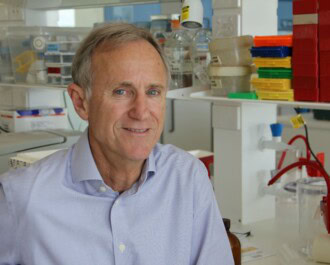
Breast cancer therapies are most effective when the cancer remains in the breast tissue, but once it spreads (or metastasises), it becomes more challenging to control. As such, it is important to identify the ways in which cancer cells can move around the body.
A new NBCF-funded study has identified one such factor – a molecule known as Rac1. This molecule makes breast cancer cells more resilient as they spread from the initial tumour, enabling metastasis to other areas of the body. In particular, Rac1 protects cancer cells from the “shearing” stress due to movement within the blood stream.
The study was led by Professor Paul Timpson and Dr Max Nobis from the Garvan Institute of Medical Research. Their team developed a new imaging technique to observe the activity of the Rac-1 molecule in a living mouse model.
“We found that Rac1 was most active near blood vessels or at the border of the tumour, where cells were primed to move into the blood stream. Further, we discovered cancer cells could transit to different organs in clusters where Rac1 was more active at the outer surface. This helped the cancer cells be more resilient to the physical stresses that occur when cells leave a solid tumour and enter the blood stream to invade other tissues, such as the lung,” says Dr Nobis.
Having discovered the important role Rac1 plays in the spread of cancer, the team then investigated whether blocking the molecule could stop metastasis. Using an experimental drug, they were able to reduce the cancer spread in preclinical models by 73%.
“When we targeted Rac1, the breast cancer cells became more vulnerable to any shear stress they encountered in the blood stream and became far less likely to survive the journey,” says Dr Nobis.
Excitingly, there are already drugs on the market that can target Rac1, such as non-steroidal anti-inflammatory medications (NSAIDs). Some NSAID drugs are already being used in the treatment of metastatic ovarian cancer, leading to improved patient outcomes.
“The insights obtained in our study suggest existing treatments could be repurposed to reduce breast cancer metastasis. This could potentially fast-track the new approach to patients,” says Professor Timpson.
The team believe that combining Rac1-inhibiting drugs with standard chemotherapy may be an effective way to reduce the risk of breast cancer spread and recurrence. Future work will investigate the use of Rac1 inhibition as a treatment option, and also utilise this new imaging modality to learn more about breast cancer growth and spread.
The study was published in the journal Cell Reports, and proudly supported by the National Breast Cancer Foundation.
More News Articles
View all News


